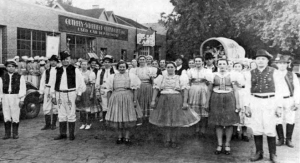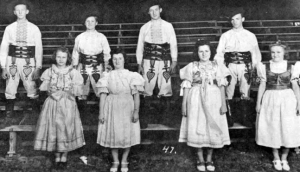Part IV: The Slovak Community of Cleveland
Education for Second Generation Americans
When my immigrant parents and other first generation Americans had children of school age, they had to make a crucial decision about the value and extent of their education, especially about the relative merits of public versus parochial schooling. In the Old World the ruling Magyars made this decision for the subject nationalities. From 1872 until their liberation in 1918, Slovaks in Hungary suffered the indignity of seeing their parochial schools closed and replaced by state institutions which specialized in Magyarizing their children. American Slovaks, therefore, had a healthy suspicion of public schooling and this attitude was reinforced by both their lay and religious leaders. In a content-analysis of Jednota, the Catholic weekly published in Cleveland, it was found that between 1902 and 1911, 17 articles discussing schooling appeared and they contained 31 discrete statements about its worth. The vast majority praised parochial education for cultivating morality and preserving the children’s language and nationality. Seldom, if ever, did the idea of education for the purpose of social mobility arise. Secular newspapers, such as Amerikánsko-Slovenské noviny, published in Pittsburgh, revealed similar sentiments in the years 1893-1902.
Public School vs. Catholic School
The true aim of schooling, as perceived by Slovak priests, lay not in preparing children for advancement on this earth but in molding good Christians who would receive their eternal reward in heaven. Father Stephen Furdek, for instance, joined his colleagues Andrej Pavčo and Ján Porubský in denouncing public education. Pavčo labelled public schools as “anti-religious” and blamed them for all the immorality present in America. Ján Porubský denounced these institutions for teaching “anti-Catholicism” and for receiving state aid for such immoral purposes. Furdek, while agreeing with these observations, compared the relative merits of public versus parochial education and chose the latter as best. He admitted that public schools were free, that they supplied books and clothes to poor children, that they had nurses to care for the sick and small classes of only thirty to forty pupils taught by teachers with diplomas. Slovak parochial schools, on the other hand, were expensive, they were overcrowded and many of their teachers lacked diplomas. In spite of the short-comings of parochial schools at the turn of the century, Furdek still believed them to be superior to public institutions because “the saving of souls was more important than a good secular education,” and parochial schools, by teaching catechism, fulfilled this essential role while public schools did not.
Slovak distrust of public schooling revealed itself quite clearly when members of larger parishes built their own schools and had their children educated at these institutions. Every single Slovak Catholic parish in the Cleveland area had a parochial school within a few years of its founding. So did the Lutheran parishes of Holy Trinity and SS. Peter and Paul. Only the smaller congregations, which could not afford their own schools, did without. Furthermore, in their analyses of parochial education, Josef Barton and Mark Stolarik have both discovered that where a congregation had its own school, such as at St. Wendelin’s, more than three-quarters of all the children attended it in the years 1910-1930. Hence, the majority of parents listened to the advice of their leaders and gave their children parochial educations.
High School
While 12% of native Americans in Cleveland attended high school in 1908, only .5% of Slovaks did so. Furthermore, one quarter of all children at Slovak parochial schools in the first third of the twentieth century dropped out before reaching the eighth grade and only 22% of those who entered junior high in the 1920’s and 1930’s reached senior grades, a figure that was well below the national average. In explanation of this rather poor record, it is noteworthy that many of these young people were needed to help with finances at home, since their fathers had been given the most menial and poorest-paying jobs. The Slovak also held the basically Catholic teachings that any type of work is honorable so long as it is done well and promotes the well-being of the community and that education served primarily to preserve a child’s morality and nationality. Catholics at the turn of the century did not view social mobility in the traditional middle-class Protestant fashion, that is, moving up from blue to white collar work and out of the old neighborhoods into the suburbs.


